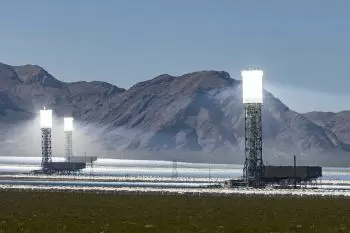
Solar thermal power plants are solar-powered facilities. They are examples of active solar energy since they use mechanisms and technology to improve solar gain and performance.
These types of plants make it possible to take advantage of solar radiation to produce electricity.
On the other hand, passive solar energy is a way to harness solar energy without using external elements. There are many techniques to take advantage of natural light and naturally occurring drafts to improve the thermal performance of a home. Passive solar energy is the basis of bioclimatic architecture.
How does a solar thermal power plant work?
Solar thermal power plants are thermal power plants that use solar energy directly as an energy source. To work, they have a type of solar collector that reflects energy at one point. Depending on the kind of solar facility, they can use flat plates or heliostats.
The amount of concentrated solar radiation makes the system heat a fluid raising its temperature to rise and, consequently, its thermal energy. With thermal energy, we obtain steam that can drive steam turbines. Steam turbines transform this energy into electricity.
{youtube:ADbUsuNeRQE}
What active systems does a solar thermal power plant use?
The main active elements that a thermal power plant uses are:
-
Solar trackers. The followers are necessary to orient the solar collectors correctly at all times.
-
Hydraulic pump to keep the fluid in the internal circuits moving.
-
Steam turbine, to convert thermal energy into mechanical energy.
-
Electric generator, which converts mechanical energy into electrical energy.
Usually, installing solar panels in this kind of active solar system is done using fixed supports to reduce maintenance costs. However, this system is not possible because the Sun’s position varies from moment to moment, and the central receiver remains fixed.
What are the advantages of a solar thermal plant?
Obtaining energy through a solar thermal plant offers the following benefits:
-
It does not emit greenhouse gases and therefore does not contribute negatively to climate change.
-
It represents a significant saving of PV panels.
-
Maintenance costs are much lower compared to other thermal power plants.
-
The source of energy used is endless. Thus, it uses a type of renewable energy.
What other examples of active solar energy are there?
Solar thermal power plants are among the many solar thermal energy uses and are usually huge installations. Another use of solar thermal energy is, for example, the use of solar panels to obtain sanitary hot water.
In domestic hot water installations (DHW), hydraulic pumps are frequently installed to improve the circulation of the heat transfer fluid. Commonly, they have storage tanks that work as heat storage.
Another example is the use of fans and elements to promote heated air circulation thanks to solar radiation.
Active solar heating systems often use pumps or fans to circulate heat water, but also, they can have air collectors to improve their performance. This technology can work equally as a home heating and as space heating systems.